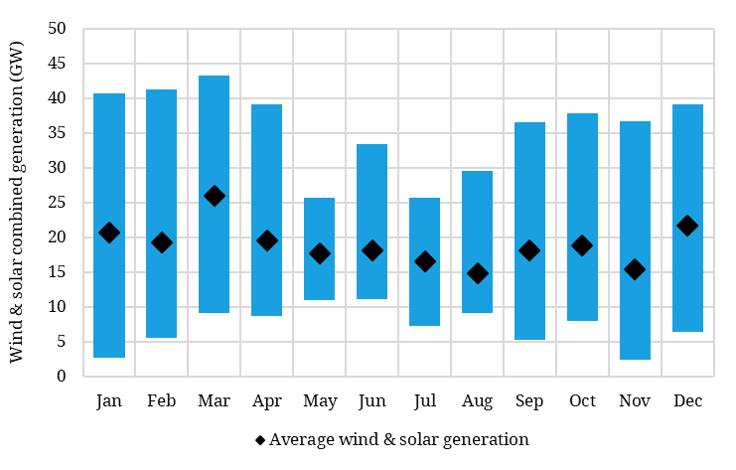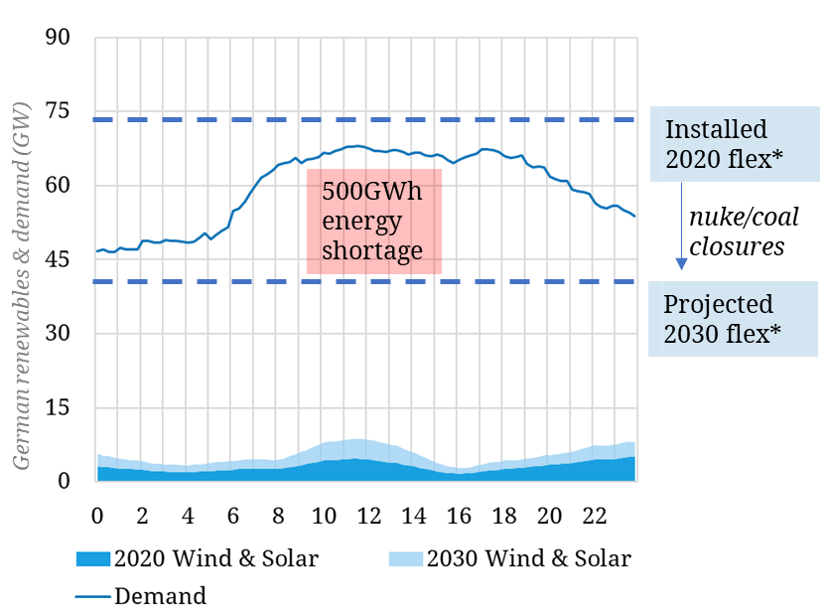Two case studies of renewable intermittency-Timera
By Paul Homewood
An interesting analysis by Timera of the woeful shortage of back up capacity in Europe, based on German renewables performance:
Two case studies of renewable intermittency
Europe is leading a global push to decarbonise power markets with renewable energy sources. Decarbonisation looks to be a tough but achievable challenge, with wind & solar capacity set to do the heavy lifting.
More than 350GW of new wind and solar is projected to come online across Western Europe over the next 10 years. At the same time, large volumes of dispatchable nuclear, coal & lignite capacity are due to close, at least 40GW by 2023 and 80GW by 2030.
We set out the challenges of such a rapidly changing European capacity mix in a recent article. This highlighted what in our view is a substantial shortfall in flexible capacity investment in order to support growing wind & solar output volumes.
In today’s article we use two case studies to illustrate the flexibility required to support renewable output swings in 2020 compared to 2030. We also consider the assertion that these swings can be supported by electricity storage alone (e.g. batteries).
The full post is here.
Below is the key section. Bear in mind it relates to Germany alone:
Case study 1: Low renewables day
Our two case studies are based on actual recently observed load, wind & solar data in Germany (the 2020 case). We then scale up wind & solar output based on the projected capacity growth required to meet the latest German 2030 renewable policy targets. Chart 3 plots our low renewables case study day.


The dark blue shaded area at the bottom of the chart shows 2020 wind and solar output across a given 24 hour period. The blue line shows power demand. The top blue dashed line on the chart shows the level of installed dispatchable (‘flex’) capacity in 2020 (just under 75GW). In other words there is a comfortable volume of dispatchable capacity to cover low wind & solar output days in 2020.
Now let’s consider 2030. The lighter blue shaded area at the bottom of the chart shows the incremental increase in wind & solar output in 2030. Despite the large increase in nominal renewable capacity, there is only a relatively small increase in output on a low wind & solar day.
In contrast there is a more than 30GW reduction in dispatchable flexible capacity by 2030. Nuclear, coal & lignite closures drag the blue dashed line down to a level that leaves an approximately 500GWh energy shortage across the day. This is the equivalent of 250GW of 2 hour average duration storage.
In practice, only a portion of this energy gap can be plugged by storage. Interconnectors will also play a role, although a relatively high correlation of wind patterns across NW Europe means Germany’s neighbouring markets may be in a similar position. But there is a substantial requirement for investment in new flexible capacity e.g. in the form of batteries, gas peakers and demand response.
As I have been pointing out for a long while, storage and demand supply response (DSR) are of little use in covering for renewables intermittency.
Even if daily supply and demand could be perfectly smoothed within 24-hour periods, Germany would still need to cover for that missing 500 GWh, equivalent to a capacity of 21GW.
Timera sum up:
We do not mean to downplay the role of electricity storage, particularly batteries. Storage is set to play a key role in absorbing excess energy, peak shaving and providing very high speed balancing. But storage is a net consumer (not a producer) of energy and current technology (e.g. 1-2 hour duration batteries) have limited practical application for shifting large volumes of energy.
There is also large potential for broader engagement of the demand side. But the flex characteristics of demand side response are typically similar to storage i.e. shorter duration and at best net energy neutral.
Interconnectors can help shift energy from lower to higher valued locations. But the rapid deployment of renewables across Europe will increasingly see neighbouring countries with correlated tight or oversupplied market balances.
Current policy support across Europe is grossly inadequate to support the required volumes of flex from low carbon sources. Even heroic assumptions on storage, demand response and interconnector deployment do not close the flexibility deficit in markets like Germany.
That leaves conventional gas-fired generation playing a structural flexibility provision role well through the 2030s, albeit at steadily declining load factors. And that is not an outcome that is inconsistent with net zero emissions targets in 2050. Gas generation is effectively buying time for the commercialisation and scale up of low carbon flex capacity such as hydrogen and longer duration storage.
In reality, hydrogen and longer duration storage remain pie in the sky, and certainly not options you would want to build an energy policy around.
Which brings us back to gas.
Comments are closed.

The German energy policy is almost as mad as the UK’s, but at least they can question theirs. Blind belief in selected scientists is the source of the problem; once the science has been “settled” by the select group, it is possible for the madmen to run the asylum.
“Interconnectors can help shift energy from lower to higher valued locations. But the rapid deployment of renewables across Europe will increasingly see neighbouring countries with correlated tight or oversupplied market balances.”
Lulls tend to affect multiple neighbours simultaneously.
No, no, hydrogen will save us.
https://uk.reuters.com/article/us-hydrogen-investment-study/carbon-free-hydrogen-production-needs-multi-billion-dollar-subsidies-to-make-it-cost-effective-research-idUKKBN21H1SC
All it needs is for half the subsidies currently paid to prop up fossil fuel to be paid to this instead. That will make it cheaper than natural gas – see?
(sarc – just to be clear)
What subsidies are being paid to prop up fossil fuel? Did you mean to write “to prop up renewables”?
Over $300 billion of subsidies for fossil fuel consumption is what is claimed in the article, tim.
Nope – as Roger says these people believe there is money on the table that is currently being paid to fossil fuel providers that should be re-directed to this boondoggle (or since we are British – white elephant) instead.
Figure you missed the (sarc).
Apologies for replying to myself really – and off topic. But white elephant is Thai in origin (a gift that costs more to keep up than it is worth) and I’m struggling to find a British phrase! Rip off, snow job, pull a fast one, shell game, flim flam, hustle – all American.
We Brits must be an honest lot.
Pig in a poke? Surely that is ours?
The “subsidies” to fossil fuels that are calculated in these studies are mostly not subsidies in the common sense of the word.
In my view, the common sense of the word “subsidy” would be government handing out money to something so that it can be purchased at less than cost. Or keeping the local price well below the international traded price. When the IMF talks about ending fuel subsidies in many countries of the world, this is what it means. Fuel subsidies of this kind are mainly found in less developed countries, like Egypt and Indonesia, and some large oil producing countries like Iran and Venezuela.
But the “subsidies” of these studies are mostly in the form of paying a lower rate of tax than something else pays. It assumes that the highest possible rate of tax is the “normal” rate of tax, and anything paying less than that is “subsidised” by the difference. So your 5% VAT on domestic energy isn’t a 5% tax, it’s a 15% subsidy because you aren’t paying 20% VAT.
Demand management is a euphemism for Big Brother control of our lives. you will never know whether your EV has been charged up, or at what cost. And if you complain ???
Beware the smart meter.
Batteries create worse health issues, the scottish village are saying they’ll have to relocate which is a travesty. Nobody will open the pits to pay a new generation of miners, they are fast losing the ones with experience, and it’s all to force us to accept nuclear which costs them nothing.
It’s rather strange that coal mining has not entered the robotic age. I would have thought that mining for coal had moved on from the days when men and boys were sent underground to recover the valuable fuel. But then, I also figure that vested (union) interests had a hand in making sure that nothing changed or advanced.
The conclusion at the end of the article makes a point that they will need gas for some time to come (As will the U.K.)
“That leaves conventional gas-fired generation playing a structural flexibility provision role well through the 2030s, albeit at steadily declining load factors. ”
The point about load factors means, of course, declining revenue for the owners and subsidies will be required to keep an essential service operating. In other words even more cost per unit to the consumer. Also should gas plant require replacing, there is little attraction for investors to build them.
As the U.K. is following Germany in the expansion of renewable generation, this should be a warning call but is there anyone in the government listening or even concerned?
One wonders if they are. This can keeps getting kicked down the road, with more marvellous targets for “Carbon Neutral by ….”
No, there only a handful of MPs capable of understanding anything. They have been convinced there is a climate emergency and they think it will make them popular if they take action to solve it. The ill-informed and increasingly dim people who want action on global warming haven’t clue what it will do to their way of life.
As regards building gas plants in the UK, there are already no takers and a plant approved in Trafford, Manchester was shelved as it didn’t make economic sense to proceed.
Thanks Paul,
We are sitting on the edge of a high precipice. When Germany ceases to be Europe’s largest electricity exporter, after France, there will be much less electricity available to import to UK, Europe’s largest importer after Italy.
This is clearly described in the latest article published by Paul-Frederik Bach at http://pfbach.dk/firma_pfb/references/pfb_flows_and_congestions_in_2019_2020_02_21.pdf
What NW Europe, including UK, will do in the middle of one of those 2 week long anti-cyclones that happen during most winters, to keep the lights on, is a mystery. 60 GW of coal, gas and nukes are due be decommissioned by EU edict before 2030.
Heaven help Europe!
fear not Elon will save us – https://www.dailymail.co.uk/sciencetech/article-8082841/Elon-Musks-Tesla-battery-farm-saved-South-Australia-116-MILLION.html